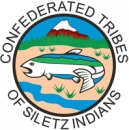Researchers from Oregon State University, the Confederated Tribes of the Siletz Indians and the Institute of Applied Ecology has been collecting data on vegetation, soil conditions and accretion, water quality, and fish passage fish passage
Fish passage is the ability of fish or other aquatic species to move freely throughout their life to find food, reproduce, and complete their natural migration cycles. Millions of barriers to fish passage across the country are fragmenting habitat and leading to species declines. The U.S. Fish and Wildlife Service's National Fish Passage Program is working to reconnect watersheds to benefit both wildlife and people.
Learn more about fish passage to monitor the success of the Ni-les'tun Marsh restoration project over time. The Bandon Marsh has been used as a control site for these studies. The work conducted in 2020 will be published soon and we hope that this monitoring work continues to inform the success of our management actions in future studies.
The following is the abstract from the original Oregon Watershed Enhancement Board:
With 418 acres of emergent tidal marsh and 12 acres of forested tidal swamp, the Ni-les’tun restoration project in the Coquille River watershed several miles northeast of Bandon (Coos County) is one of the largest tidal wetland restoration projects completed in Oregon to date. Periodic effectiveness monitoring is essential for evaluating project results and the rate of ecosystem change, but most essential monitoring parameters have been monitored only once since restoration (in 2013). This proposal builds on previous OWEB-funded monitoring to characterize: (1) the status of site hydrology; (2) plant community development; (3) soil conditions (plus links between soils, groundwater hydrology, and plant communities); (4) aquatic habitat availability, quality, and utilization by fish (plus
fish prey); and (5) climate change climate change
Climate change includes both global warming driven by human-induced emissions of greenhouse gases and the resulting large-scale shifts in weather patterns. Though there have been previous periods of climatic change, since the mid-20th century humans have had an unprecedented impact on Earth's climate system and caused change on a global scale.
Learn more about climate change adaptation potential of the restored site. Project partners include the Institute for Applied Ecology, Oregon State University, the Confederated Tribes of Siletz Indians, and the US Fish and Wildlife Service. Results of our monitoring will provide accountability for OWEB's prior investments in this project, and through outreach, will help advance restoration practices and guide similar restoration projects in Oregon. We will widely distribute project results to the public via a synthesis report, outreach activities, and user-friendly datasets. Project outcomes will include valuable data on wetland restoration effectiveness in the Coquille River Estuary a decade following restoration, data on how physical drivers relate to biotic communities, and restoration lessons learned for application to other restoration projects throughout Oregon.




